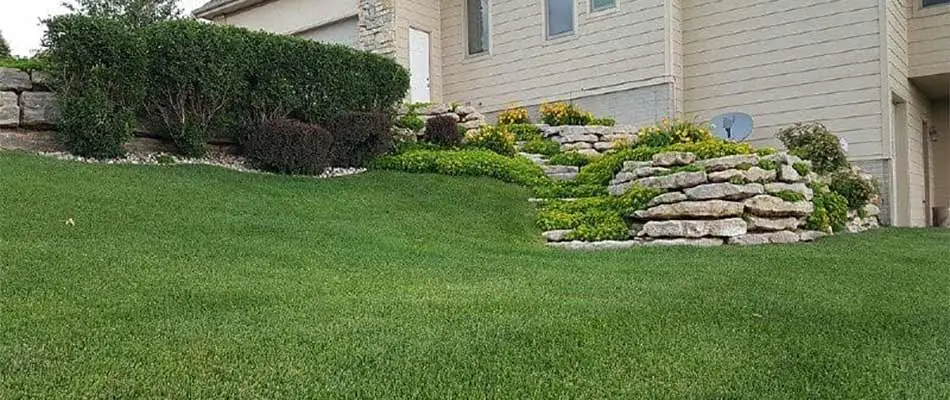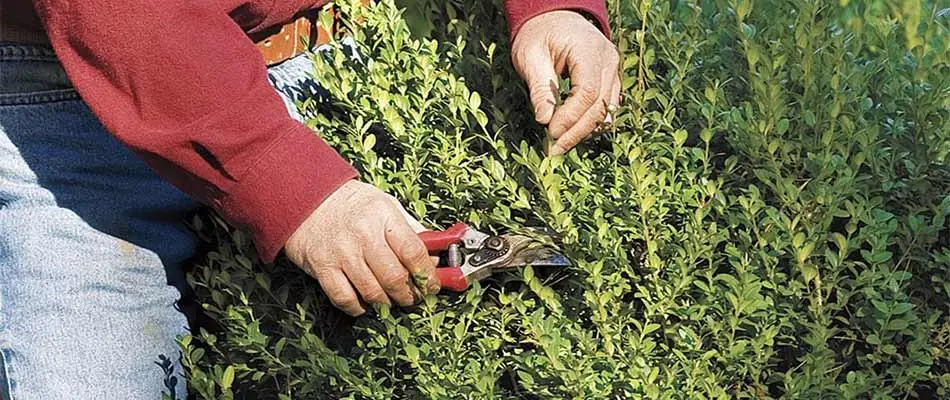You’ve raked up the last of the leaves. The growing season is over, so there’s no more mowing until the spring. Cold temperatures have arrived. Snow and winter are on their way.
Like a big old grizzly bear, you’re ready to go dormant for the winter. Okay, maybe you can’t hibernate in a warm den and sleep the cold months away, but you’re planning to spend as much time as you can inside, warm and cozy.
At least you can take a break from the lawn for a few months.
Well, You Can't. Or You Shouldn't. Not Entirely.
So the good news is that you really can put off mowing, weeding, planting, and the like until spring returns. However, it would be best if you got out to do some pruning of your trees and shrubs.
Winter, when growth in trees and shrubs goes dormant, is the best time for pruning. Because of the season, we call this dormancy pruning, and it’s the subject of this article. In this region, we perform dormancy pruning from late fall through early spring.
Dormancy pruning provides you with an opportunity to prune, thin, and shape your ornamental plants to get them ready for the new growing season in the upcoming spring, summer, and fall.
We know: you could use a break! Here at Sharp Lawn Care, we’re able to provide that much-needed break, but before we get to that or in case you think you want to do this yourself, let’s talk about why dormancy pruning is vital for your trees and shrubs. Without it, they could be left in harm’s way, but that’s not the only reason for it.
First, Why is Pruning Important in the First Place?
Pruning trees and shrubs have several benefits: structure, growth, longevity, safety, views, and air circulation.
- Structure: Pruning for the structure is immensely beneficial when a tree is young. Early pruning helps develop a strong structure, which results in an aesthetically pleasing appearance as well. With structural pruning, a tree needs less corrective pruning as it gets older. Without it, the tree can get ugly and overgrown, and it might need complicated, expensive attention to mitigate or repair.
- Growth: Good pruning promotes healthy growth and helps control growth you don’t want, like shoots, suckers, and water sprouts. If you neglect this pruning type, you will allow development in places that will interfere with proper growth.
- Longevity: When you routinely and correctly prune your trees and shrubs, they live longer than they would without such care. Proper pruning also helps boost a plant’s resistance to snow, ice, and other harsh winter conditions. (And it’s safe to say we get a little of that around here!) Removing branches that cross each other and rub against one another also makes the tree or shrub healthier and promotes a longer lifespan. The consequence of not doing this is obvious: your tree or shrub doesn’t live as long as it should, which can affect your property’s appearance and lead to expenses related to removal and replacement. And to be honest, if you lose a large tree before its time, it could change your property’s character for the rest of the time you live there.
- Safety: Dead, broken, overgrown, and diseased branches on shrubs may be merely ugly and might at worst scratch the car, but they’re no joke on trees. Dead or weakened tree limbs can fall and injure (and kill) people and damage property. They can also block visibility where driveways meet streets, raising the risk of an accident.
- Views: Overgrown branches and limbs can obscure the view from your deck, your bedroom, the kitchen window, etc. Proper pruning that doesn’t harm the tree or shrub keeps it healthy ad prevents it from spoiling your view of the pond, the meadow, the sunset, or whatever else it is that catches your eye.
- Air Circulation: By thinning a tree’s density or shrub, you improve air circulation within it. In turn, that gives the tree or shrub better protection against diseases and damaging insects. Both can quickly cause long-lasting or fatal harm, and sometimes they can spread from one plant to another. The effects can be ruinous (and expensive).
So Why is Winter the Best Time for All of This?
People prune throughout the year, and that’s perfectly fine, provided proper technique is always top of mind. As we’ve often said, it’s essential to address a problem when it’s little, so it doesn’t get big, so advising you to wait for winter to tend to a pruning-related issue would be irresponsible.
That said, there are still some sound reasons that winter is the best time for pruning unless something demands immediate attention.
- It’s easier to see. Deciduous trees and shrubs drop their leaves by the time winter arrives. With less blocking your view of things, it’s naturally far easier not only to see what you’re doing but also to identify dead, diseased, weakened, and crossed branches and limbs. Dormancy pruning is a great way to get them out of the way in time for the new growing season and before whatever ails them can spread to further growth.
- There is less sap loss. Reduced sap loss means less stress on the tree.
- The risks from disease and insects are lower. In the winter, insects and other factors causing damage or disease go dormant, too, or at least they slow way down. That makes them far less likely to infest or infect the fresh cuts that pruning leaves.
- “Wounds” heal faster. The cuts you make when pruning also recover more quickly during the dormant season, and they can’t impede new growth. Thus, the tree or shrub is ready for spring when it arrives.
- Spring growth is better. The faster healing after dormancy pruning primes the plant or tree for healthy new growth as soon as the growing season returns. Just as we recommend fall seeding as a way to establish a strong base for developing the following spring, preparing it for the harsh heat of summer, we recommend dormancy pruning for the same reasons. The new growth has the time it needs to get strong enough to endure the hot summer.
- Decluttering tree canopies is easier. More sunlight penetrates the base with less foliage, benefitting grass and other plants in the understory.
Before You Start
Now, before you head out into the yard with shears and loppers and snippers and whatever other cool toys you got at the local garden center, you need to know about things you should not do! These are things that can harm your plants, whether you’re pruning at the best time or not.
- Don’t snip the tips! It’s better to make fewer, larger cuts than to make several smaller ones. Snipping tips off, even though you’re cutting growth back, actually stimulates growth. As a result, you can end up with many new branches taking the place of the one you’ve snipped, creating clutter, distorting the shape, and possibly blocking sunlight from reaching parts beneath.
- Avoid topping off shrubs. “Topping” is the act of shearing away the top of a shrub, which stimulates new growth in directions you can’t control. You’ll end up having to go back and correct. When you prune, it’s better to follow natural lines instead of creating arbitrary ones.
- Be careful not to cut too much off. First, make sure you don’t prune more than a quarter of a plant during a single season. Over pruning can lead to excessive unwanted growth, including sucker growth, which refers to odd branches growing from a tree’s roots or base. Also, always take your time and include pauses to step back and assess to ensure you’re not overdoing things.
- No leaving stubs! It would be best if you always cut back to buds or branches. If you cut somewhere else and leave a stub, you can wind up with unsightly sucker growth. The plant is also more susceptible to disease when there are open ends. Pruning just above a bud lets a new branch grow from the bud, which you want. Also, you want buds to face outwards so that new growth goes in that direction as well.
- For dormancy pruning of evergreens, talk to someone who knows. Some sources will tell you never to prune evergreens during the dormant season. Others will say that’s true for needle-leaf evergreens but not for narrow-leaf and broadleaf evergreens. Before you decide to treat your evergreens to some dormancy pruning, consult an expert at a gardening center or a landscaping company.
Complete Landscape Maintenance from Sharp Lawn Care

Of course, the biggest mistake you can make when it comes to pruning is not pruning at all. While people often attribute that to laziness or procrastination, we know that’s not always the case. Maybe you don’t have the tools for the job. Perhaps you’re afraid of messing up and causing more harm than good.
As part of our landscape maintenance packages, Sharp Lawn Care includes pruning done the right way and at the right time. Your landscaping will receive the best care available, and you don’t have to have any of the worries about finding the time or doing things the wrong way.




Comments (0)
Thanks for your comment!
Thanks for your feedback! Your comments have been successfully submitted! Please note, all comments require admin approval prior to display.
Error submitting comment!
There is a problem with your comment, please see below and try again.